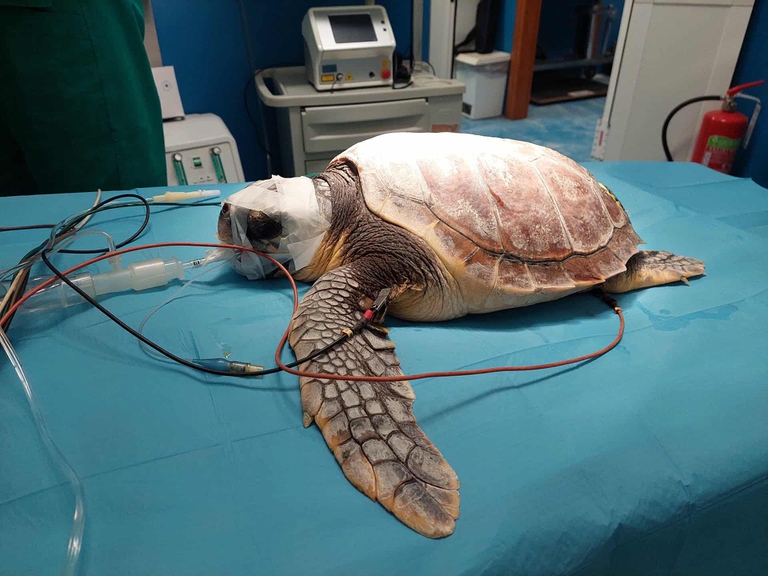https://www.lifegate.it/guscio-tartaruga-3d-cenere
- |
- Cestha (Experimental Center for the Protection of Habitats) of Marina di Ravenna and the Cattolica aquarium have started a collaboration for the implementation of research activities relating to the conservation of the fauna of the Adriatic Sea
- The first result of this agreement is the arrival for the rehabilitation of Cenere, a specimen of the Caretta caretta sea turtle recovered at sea in desperate conditions and now on the road to recovery
- Thanks to 3D printed prototypes of artificial carapaces, Cenere has made considerable progress and is now swimming again.
Technology at the service of the animal kingdom:the Cattolica aquarium and the Cestha of Marina di Ravenna join forces for an innovative project.The rehabilitation of Cenere, one sea turtle of the Caretta caretta species, was created thanks to 3D printing.Using innovative technology, the animal's shell was reconstructed after having suffered a deep cut injury.This is the first five-year collaboration project between the two entities that aims to develop fauna research and conservation activities of the Adriatic Sea.It was Cenere who benefited from it, and was thus able to gradually return to swimming.

The story of Cinder and her 3D shell
Cenere was found in critical condition at off Cervia in July 2020, with a deep lesion on the carapace which also compromised a lung.The turtle was rescued and treated at Cestha, where 3D printed prototypes of artificial shells were used to aid its recovery.Thanks to laser-scanner technology and 3D printing, in collaboration with the Artificio digital company from Ravenna, six artificial shells were created, fixed with epoxy glue to guarantee the stability and protection of the wound.These models have evolved over time, adapting to the turtle's growth and healing needs.THE shield models they represented an innovative solution, guaranteeing the stability and protection of the wound, isolating it from water but allowing watertight access at the top to allow routine dressings.
Now Cenere faces a new challenge: regain mobility compromised by the vertebral lesion which caused partial paraplegia of the hind fins.To support you at this stage, the Cattolica aquarium provided her with a large tank, with a capacity of 80,000 liters of sea water and a reconstructed natural environment, ideal for her motor rehabilitation.The tank will allow Cenere to develop a different way of swimming, mainly using his front fins.Cestha staff and aquarium staff they will monitor progress daily of Cenere, with the aim of preparing it for a future return to sea.Optimistic Sara Segati, Scientific Manager of Cestha, declared:“The depth and size of the tank will play a crucial role in improving Ash's mobility.The greater water pressure will help maintain the physiological balance, stimulating the muscles and swimming coordination.The rest will be done by Cinder, who has proven to be gritty and tenacious from the first moment, and has endured 11 surgeries“.
View this post on Instagram
3D technology to help animals
There 3D technology is proving to be an asset valuable in the field of veterinary medicine and animal protection.The use of laser-scanners and special printers allows the creation of customized prosthetics, artificial shells and others devices that can improve the quality of life of injured or disabled animals.For example, in South Africa, a sea turtle called Bagheera received a 3D-printed prosthesis after losing part of its shell due to an infection.Another turtle, Freddy, received an artificial shell in Brazil after his was damaged in a fire.Birds have also benefited from this technology:a toucan in Costa Rica received a 3D printed beak after losing his in an attack;of the birds were able to fly again and land freely thanks to the addition of legs printed in the laboratory.
These innovative tools allow you to intervene in a precise and adaptable way, offering tailor-made solutions for each individual case.Cenere's story is a clear example of how technology can make a difference in the care and rehabilitation of wild animals, promoting their conservation and well-being.“Returning Ashes to the Sea, strong and autonomous, is our goal”;concludes Simone D'Acunto, director of Cestha.“The collaboration with the Cattolica aquarium allows us to take a decisive step towards achieving this goal”.
